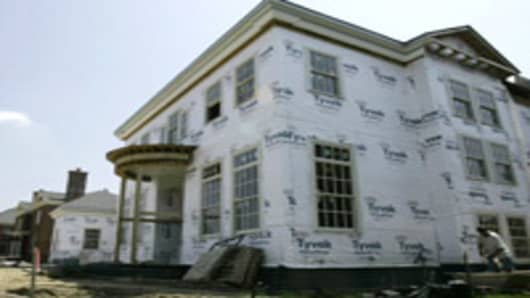The overall real estate recovery may be lukewarm, but home builders are hot.
Continued signs of stabilization in the market, from a reversal of falling home price to a tightening in credit spreads, have analysts optimistic about the builders' future. Combine that with the likely prospect of continued aggressive government intervention and it makes for a potent recipe in the industry.
"The real estate companies, especially the home builders, are adapting to a new environment, and that's an environment where credit isn't as loose as it used to be," says Steven M. Roge, portfolio manager at the Roge Partners Fund in Omaha, Neb. "Certainly that's going to be a change from what a lot of these home builders are used to, but I don't doubt their ability to adapt."
Since the housing market began to collapse in 2007 builders have worked feverishly to recover.
They've cut inventory, stopped speculative building and slashed prices as consumers with little credit availability were pushed out of the new-home market.
But in that time mortgage rates have turned lower, prices in most markets have stopped their freefall and sales of new homes have started to recover.
August data shows new home sales increased 0.7 percent which, though below expectations, cheered investors because the group managed to continue the winning streak it began four months previous. Given a corresponding drop in inventory, analysts have suddenly grown bullish again on the building industry.
"Given our outlook for demand to continue to slowly recover over the next 24 months, combined with supply becoming less elevated, we reiterate our positive sector stance," JPMorgan Chase analyst Michael Rehaut said in a recent analysis.
The firmis overweight three of the five large-cap builders it covers—KB Home , Lennar and Toll Brothers.
Similarly, Goldman Sachs recently upgraded the entire sector to "attractive," citing the positive environment in the industry that it believes will lead to greater sales activity.
The firm projects sales to grow 50 percent in the next two years and believes government programs also will give the industry a boost.
"Additionally, we give a greater than 50 percent probability of a federal tax credit extension which should allay fears of a 'double dip' in housing," the brokerage wrote in a note to clients.
Finally, New York broker-dealer Oscar Gruss initiated coverage on the group this week, saying it's time to "go long homebuilders" and opened D.R. Horton and KB Home with "buy" ratings.
"We recognize that most investors remain skeptical about the prospects for any sort of near-term housing recovery, especially given the rise in mortgage delinquencies and foreclosures," analyst Jeffrey R. Laverty wrote. "However, we would caution investors not to draw too many comparisons between the still-sluggish markets for existing homes and the improving conditions in new home construction.
"Indeed, we see a number of reasons to suggest that the recent strength in new home building activity is both legitimate and sustainable."
Investor Options
For investors, there are a multitude of ways to capitalize on the trend aside from simply buying builder stocks.
Real estate investment trusts, mutual funds and exchange-traded funds offer an array of opportunities, though investors need to be selective.
The opportunities to invest in home builder REITs are mostly indirect because of the requirements attached to the investment vehicles.
But some of the more popular names in the group—Kimco , Simon Property Group and Vornado Realty Trust —allow investors to benefit from ancillary gains in building growth.
Real estate REITs, though, have been a mixed bag lately; a handful of mortgage REITs that recently went public disappointed in their initial public offerings.
ETFs allow investors to participate more directly in the growth of home building.
The most popular fund in the group is the SPDR S&P Homebuilders ETF that holds a fairly equally-weighted group of stocks that mimic the industry's movements. The fund has outperformed the S&P in the equities rally off the March lows with a gain of 88 percent.
There's also the more lightly traded iShares Dow Jones US Home Construction ETF that has Pulte Homes as its largest holding. The ITB hit a closing low of $6.45 on March 6.
Among mutual funds, the best performers in 2009 have been the Grubb & Ellis AGA Realty and Fidelity Real Estate funds, which have returned 53 and 38 percent respectively, as of the third quarter.
"The first decision people should make is, do they buy into this asset class in general?" says Clint Edgington, partner at Beacon Hill Advisory in Boston. "If they buy into the idea of creating a portfolio with different asset classes, real estate should be in there."
Edgington cautions that one of real estate's strongest assets is its low correlation to the equity markets, a trend that doesn't hold up as well with buying ETFs and similar assets.
And it's also well to note that the enthusiasm for home builders is not unanimous.
Citigroup last week issued a warning about the group that the rally may be overdone and prices could be set for a fall. The firm based its opinion in part on the notion that the market is not likely to follow past trends—when builder stocks traditionally rose after the market bottoms—because continued contagion in the industry will make this recovery different.
"Despite the fact that we think the worst of the housing downturn lies behind us and that better days are ahead, we cannot justify owning any home-building stocks at current valuations," Citi analyst Josh Levin wrote.




